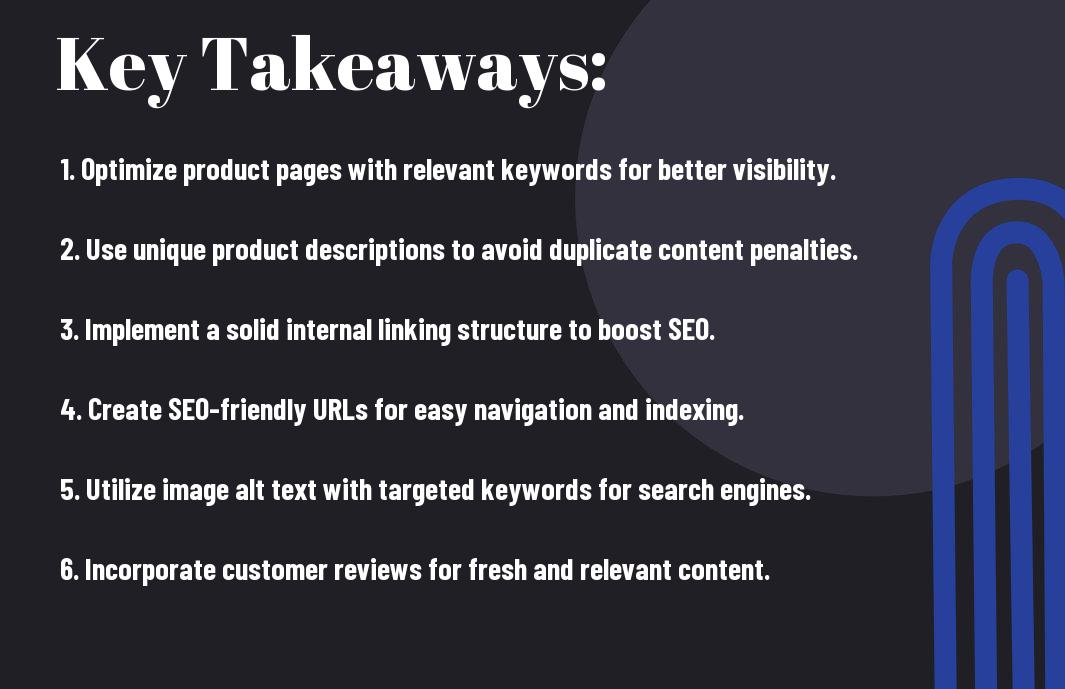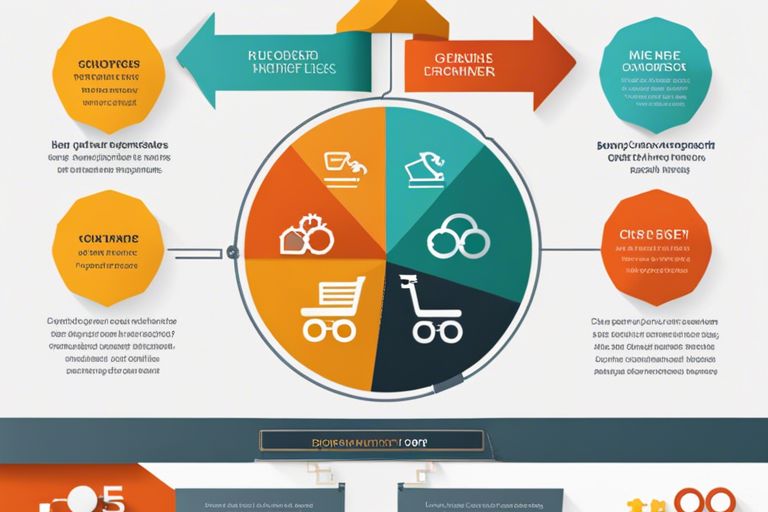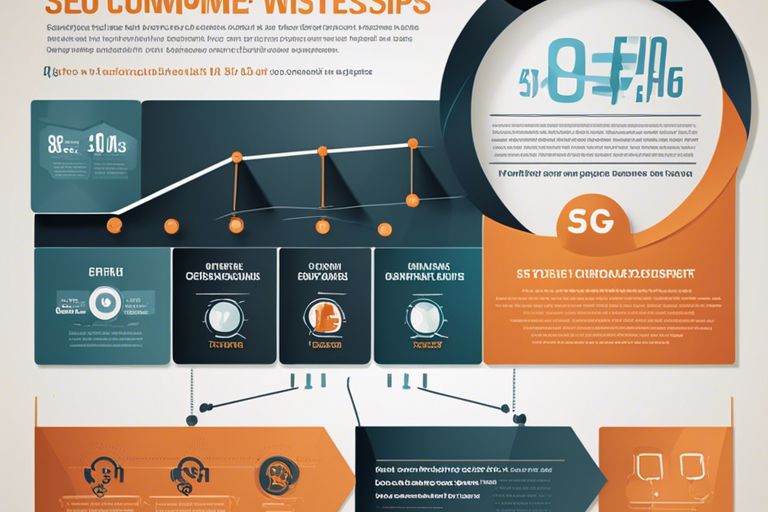With the ever-increasing competition in the online marketplace, optimizing your ecommerce site for search engines is crucial for success. If you want to drive more organic traffic, improve your rankings, and ultimately boost sales, then mastering SEO is imperative. In this comprehensive guide, you will discover the best strategies and techniques to optimize your ecommerce site and outrank your competitors. From keyword research to on-page optimization and link building, this article will equip you with the knowledge and tools to take your ecommerce SEO to the next level. Let’s get started!
The Importance of SEO for Ecommerce Sites
While having an online store is a great start, getting your products in front of potential customers is imperative for success. This is where Search Engine Optimization (SEO) comes into play. Optimizing your ecommerce site for search engines can significantly impact your online visibility, organic traffic, and ultimately, your sales.
Why SEO Matters for Online Stores
Any online store owner knows how challenging it can be to stand out in a crowded digital marketplace. Without a solid SEO strategy, your website may get lost among competitors, making it difficult for potential customers to find you. By implementing SEO best practices, you can improve your site’s search engine ranking, making it easier for users to discover your products and services online.
The Benefits of SEO for Ecommerce Businesses
Matters when it comes to SEO for ecommerce sites is that it not only helps increase your visibility but also drives targeted traffic to your website. By optimizing your online store for relevant keywords, you can attract users who are actively searching for products like yours. This targeted traffic is more likely to convert into customers, helping you boost your sales and grow your business.
To further highlight the benefits of SEO for ecommerce businesses, it’s important to note that a well-optimized site can enhance user experience and increase trust in your brand. When your website ranks high on search engine results pages, it signals to users that your business is credible and reputable. This can lead to higher click-through rates, lower bounce rates, and ultimately, more conversions.

Keyword Research for Ecommerce SEO
Identifying Relevant Keywords for Your Online Store
Relevant keywords are the cornerstone of a successful ecommerce SEO strategy. You need to think like your customers and identify the search terms they would use to find products similar to yours. Start by brainstorming a list of keywords that are directly related to your products and services. Consider using long-tail keywords that are more specific and have less competition. These keywords can help you target a niche audience that is more likely to convert into customers.
Tools for Keyword Research and Analysis
Keywords are the building blocks of your SEO strategy, and there are several tools available to help you conduct keyword research and analysis. Tools like Google Keyword Planner, SEMrush, and Ahrefs can provide valuable insights into search volume, competition, and potential traffic for specific keywords. These tools can help you identify high-performing keywords to target in your content and product descriptions, ultimately driving more organic traffic to your online store.
Keyword research tools can also give you suggestions for related keywords and help you track the performance of your chosen keywords over time. By continuously monitoring and adjusting your keyword strategy, you can stay ahead of the competition and improve your ecommerce SEO efforts.
Optimizing Product Pages for SEO
Not only does optimizing your ecommerce product pages for search engines improve your online visibility, but it also helps potential customers find and purchase your products. To make the most out of your product pages, you need to pay attention to various elements that can impact your search engine rankings.
Crafting Compelling Product Titles and Descriptions
Crafting compelling product titles and descriptions is crucial for attracting both search engines and potential customers. Your product titles should be descriptive, using relevant keywords that people are likely to use when searching online. When writing product descriptions, focus on highlighting the key features and benefits of the product in a clear and engaging manner. Remember to include relevant keywords naturally throughout the content to improve its search visibility.
Using Header Tags and Structured Data
Tags
To improve the structure of your product pages and make them more SEO-friendly, make sure to use header tags (H1, H2, H3, etc.) appropriately. Header tags help search engines understand the hierarchy and importance of the content on your page. Additionally, utilizing structured data markup can provide search engines with more information about your products, such as pricing, availability, and reviews. This can help enhance your search engine listings and attract more qualified traffic to your ecommerce site.
Titles
Using header tags (H1, H2, H3) on your product pages allows search engines to better understand the content and context of your website. It helps with on-page SEO and readability for users. Make sure each of your product pages has a unique and descriptive H1 tag that includes relevant keywords. Additionally, use H2 and H3 tags for subheadings to organize your content effectively. This hierarchical structure not only enhances your SEO but also improves the user experience on your site.
Ecommerce Site Architecture and Navigation
Organizing Your Site for Better Crawling and Indexing
Keep your ecommerce site organized to improve its chances of being crawled and indexed properly by search engines. This means structuring your site in a logical and hierarchical manner. Group related products together under relevant categories and subcategories. Use clear and descriptive URLs for each page to make it easier for search engine crawlers to understand the content.
Creating a User-Friendly Navigation and Internal Linking Structure
To enhance the user experience on your ecommerce site, it’s crucial to create a seamless navigation and internal linking structure. This not only helps visitors easily find what they are looking for but also helps search engines crawl and index your site efficiently. Make sure your site has a clear and intuitive menu that allows users to navigate through different sections effortlessly. Use internal linking to connect related pages and guide both users and search engine bots to important content.
Additionally, optimize your internal linking strategy by using anchor text that includes relevant keywords. This will not only help users understand where they are going but also signal to search engines the relevance and context of the linked pages.
Content Creation for Ecommerce SEO
Developing a Content Strategy for Your Online Store
Unlike traditional brick-and-mortar stores, your ecommerce site relies heavily on content to attract and engage customers. Developing a solid content strategy is crucial for your online store’s success. Start by defining your target audience and understanding their needs and preferences. Determine the type of content that will resonate with them and keep them coming back for more. Consider creating a content calendar to stay organized and ensure a consistent flow of fresh material on your website.
Types of Content that Drive Ecommerce SEO Success
Ecommerce sites can leverage various types of content to enhance their SEO efforts and drive more traffic to their online stores. Whether you’re focusing on product pages, blog posts, videos, or infographics, each type of content plays a unique role in attracting and engaging customers. Here are some key types of content that can help boost your ecommerce SEO:
- Product Descriptions
- How-To Guides and Tutorials
- Customer Reviews and Testimonials
- Visual Content such as Images and Videos
- Blog Posts and Articles
This table breaks down the importance of each content type:
| Content Type | Role |
|---|---|
| Product Descriptions | Provide detailed information about products to help customers make informed purchasing decisions. |
| How-To Guides and Tutorials | Help customers use products effectively and establish your brand as an authority in your industry. |
| Customer Reviews and Testimonials | Build trust with potential customers and encourage them to make a purchase. |
| Visual Content | Attractive images and videos can showcase products effectively and enhance the overall user experience. |
| Blog Posts and Articles | Drive organic traffic to your site and establish your brand as an industry leader through informative and engaging content. |
This breakdown emphasizes the importance of a diverse content strategy that incorporates various types of content to improve your ecommerce SEO efforts. By understanding the role of each content type, you can create a well-rounded content strategy that attracts and retains customers on your online store.
Image Optimization for Ecommerce Sites
The Importance of Image Optimization for Ecommerce SEO
Optimization of images on your ecommerce site is crucial for boosting your SEO efforts. Images can attract customers, enhance user experience, and improve your website’s visibility on search engines. When images are optimized correctly, they can drive organic traffic to your online store and increase conversion rates.
Best Practices for Image Compression and Alt Tags
Compression is vital for ensuring that your images load quickly on your ecommerce site. Large image files can slow down your website, leading to a poor user experience and lower search engine rankings. Additionally, optimizing alt tags for your images is key for SEO. Alt tags provide search engines with information about the content of your images, helping them better understand and index your site for relevant search queries.
Image compression and alt tags are vital components of image optimization. By reducing image file sizes through compression and incorporating descriptive alt tags, you can improve your site’s overall performance, user experience, and search engine visibility. Implementing these best practices will help you attract more organic traffic and potential customers to your ecommerce store.
Mobile-Friendliness and Page Speed for Ecommerce SEO
Why Mobile-Friendliness Matters for Ecommerce Sites
The world is increasingly moving towards mobile usage, with more and more people shopping on their smartphones and tablets. If your ecommerce site is not optimized for mobile, you could be missing out on a significant number of potential customers. Not only does having a mobile-friendly site improve the user experience, but it also plays a crucial role in your SEO rankings. Google prioritizes mobile-friendly sites in its search results, so by neglecting this aspect, you are importantly pushing yourself down in the search rankings.
Optimizing Page Speed for Better User Experience and SEO
For ecommerce sites, page speed is key to keeping your visitors engaged and converting them into customers. Studies have shown that a delay of just a few seconds in page loading time can lead to higher bounce rates and lower sales. In addition to improving user experience, a fast-loading website is favored by search engines like Google. Page speed is one of the ranking factors that Google considers, so by optimizing your site for speed, you can improve your SEO performance and attract more organic traffic.
By optimizing your page speed, not only are you providing a better user experience for your site visitors, but you are also signaling to search engines that your site is high-quality and relevant to users’ search queries. This can have a positive impact on your search rankings and ultimately drive more traffic and sales to your ecommerce site. Investing in optimizing your page speed is a crucial aspect of ecommerce SEO that should not be overlooked.

Technical SEO for Ecommerce Sites
Identifying and Fixing Technical SEO Issues
All ecommerce sites encounter technical SEO issues at some point. These issues can negatively impact your site’s search engine rankings and overall performance. Common problems include slow page load times, broken links, duplicate content, and improper URL structures. To address these issues, you need to conduct regular audits of your website to identify and fix any technical SEO issues that may arise.
Implementing SSL Certificates and HTTPS
Sites that have not implemented SSL certificates and HTTPS are at a disadvantage when it comes to SEO. Search engines like Google prioritize secure websites, and having HTTPS is now a ranking factor. By implementing SSL certificates and HTTPS on your ecommerce site, you can improve your site’s security, build trust with your customers, and boost your search engine rankings.
HTTPS encrypts the data exchanged between your website and its visitors, making it secure from hackers and other malicious actors. This not only helps protect your customers’ sensitive information but also improves your site’s credibility and SEO performance.
Local SEO for Ecommerce Sites with Physical Stores
After setting up your ecommerce site, if you also have physical stores, you need to pay attention to local SEO to drive more foot traffic to your locations. Optimizing for local search and managing your Google My Business profile are important steps to ensure your stores are easily found online.
Optimizing for Local Search and Google My Business
The key to attracting local customers is to optimize your ecommerce site and Google My Business profile for local searches. You can do this by including location-specific keywords in your product descriptions, meta tags, and URLs. Additionally, ensure that your address, contact information, and store hours are accurate and consistent across all online platforms. Google My Business is a powerful tool that allows you to manage how your business appears in Google search results and maps. Make sure to verify your listing, add high-quality images, and encourage customers to leave reviews to boost your local SEO efforts.
Building Citations and Online Directories
For improving your local SEO further, building citations and getting listed in online directories can help increase your store’s visibility. Citations are mentions of your business name, address, and phone number on other websites. By ensuring your business information is accurate and consistent across these platforms, you can boost your credibility with search engines and improve your local search ranking. Getting listed in popular online directories such as Yelp, Yellow Pages, and local chamber of commerce websites can also help potential customers discover your store when searching for products or services in your area.
Citations and online directories play a crucial role in local SEO for ecommerce sites with physical stores. By ensuring your business information is listed accurately and consistently across various platforms, you increase your chances of ranking higher in local search results and attracting more customers to your store.
Link Building for Ecommerce SEO
Despite the ever-changing landscape of SEO, one thing remains constant – the importance of backlinks. High-quality backlinks play a crucial role in boosting your ecommerce site’s search engine rankings. To improve your site’s SEO performance, you need to focus on building a strong and diversified backlink profile.
Strategies for Building High-Quality Backlinks
Building high-quality backlinks for your ecommerce site requires a strategic approach. Start by creating compelling and shareable content that naturally attracts links from other websites. Guest blogging on relevant industry sites, reaching out to influencers for collaborations, and participating in online communities can also help you acquire backlinks from authoritative sources. Additionally, leveraging your relationships with suppliers, partners, and customers can lead to valuable backlink opportunities.
Avoiding Common Link Building Mistakes
An crucial aspect of successful link building is avoiding common pitfalls that can harm your site’s SEO. One common mistake is focusing solely on the quantity of backlinks rather than the quality. Recall, a few high-quality backlinks from authoritative sites can have a more significant impact on your SEO than numerous low-quality links. Additionally, be cautious of link schemes or buying links, as Google penalizes websites that engage in such practices.
Plus, it’s crucial to regularly monitor your backlink profile and disavow any spammy or irrelevant links that could negatively impact your site’s SEO. By staying vigilant and focusing on acquiring high-quality backlinks from reputable sources, you can enhance your ecommerce site’s search engine visibility and drive more organic traffic.
Analytics and Tracking for Ecommerce SEO
Setting Up Google Analytics for Ecommerce Sites
For your ecommerce site, setting up Google Analytics is crucial for tracking and analyzing the performance of your SEO efforts. By integrating Google Analytics with your online store, you can gain valuable insights into user behavior, traffic sources, conversions, and more. This data is vital for optimizing your site and making informed decisions to improve your SEO strategy.
Sites with ecommerce functionality require specific setup steps in Google Analytics, such as enabling ecommerce tracking, setting up goal funnels for the checkout process, and monitoring product performance. By properly configuring Google Analytics for your ecommerce site, you can effectively measure the impact of your SEO initiatives and make adjustments to drive more relevant traffic and conversions.
Tracking Key Metrics and KPIs for SEO Success
On your ecommerce site, tracking key metrics and KPIs is vital for monitoring the efficacy of your SEO campaigns. Metrics like organic traffic, keyword rankings, bounce rate, conversion rate, and average order value are crucial indicators of your SEO performance. By regularly analyzing these metrics, you can identify opportunities for improvement and ensure that your SEO efforts are driving tangible results.
Success in ecommerce SEO is not just about increasing traffic but also about generating quality leads and maximizing conversions. By closely monitoring key metrics and KPIs, you can optimize your SEO strategy to attract high-intent customers, enhance user experience, and ultimately boost sales on your ecommerce site.

Common Ecommerce SEO Mistakes to Avoid
Once again, when optimizing your ecommerce site for search engines, it’s vital to steer clear of common SEO mistakes that can hinder your online visibility and rankings. By avoiding these pitfalls, you can improve your site’s performance and attract more organic traffic.
Duplicate Content and Thin Content Issues
Common ecommerce SEO mistake to avoid is having duplicate content or thin content on your product pages. When multiple pages on your site have identical or very similar content, search engines may struggle to determine which page to rank. This can dilute your site’s authority and reduce its overall visibility in search results. Similarly, thin content that lacks substance and depth can also harm your SEO efforts, as search engines favor high-quality, informative content.
Over-Optimization and Keyword Stuffing
For ecommerce sites, over-optimization and keyword stuffing are common pitfalls that can negatively impact your SEO performance. While it’s crucial to incorporate relevant keywords into your content, stuffing your pages with excessive keywords can appear unnatural to both users and search engines. Over-optimization, such as using keyword-rich anchor text excessively or unnaturally inserting keywords throughout your content, can lead to penalties from search engines.
Ecommerce SEO requires a delicate balance of optimizing your site for search engines while ensuring a positive user experience. Avoiding over-optimization and keyword stuffing can help you maintain a natural and effective SEO strategy that benefits both your site’s visibility and user engagement.
Advanced Ecommerce SEO Strategies
Many Ecommerce SEO strategies can help improve your online store’s visibility and drive more traffic and sales. To stay ahead of the competition, it’s crucial to implement advanced techniques that go beyond the basics. For a comprehensive guide on this topic, you can refer to the 2024 eCommerce SEO Strategies & Best Practices.
- Using Schema Markup and Structured Data
Markup
Schema markup and structured data play a vital role in enhancing the visibility of your products in search engine results. By adding specific tags to your website code, you can provide search engines with detailed information about your products, such as pricing, availability, and reviews. This not only helps improve your rankings but also enhances the appearance of your listings in search results, making them more appealing to potential customers.
- Implementing A/B Testing and Conversion Rate Optimization
To
Implementing A/B testing and conversion rate optimization allows you to test different elements on your website, such as product descriptions, images, and call-to-action buttons, to see which combinations result in higher conversion rates. By analyzing user behavior and making data-driven decisions, you can fine-tune your site to increase sales and revenue. This ongoing optimization process is crucial for maximizing the performance of your ecommerce store.
Another crucial aspect of advanced ecommerce SEO strategies is focusing on technical optimization to ensure your site loads quickly, is mobile-friendly, and provides a seamless user experience. By paying attention to these details and continuously monitoring and refining your SEO efforts, you can outperform your competitors and achieve long-term success in the highly competitive ecommerce landscape.
Summing up
So there you have it, when it comes to optimizing your ecommerce site for search engines, the key is to focus on high-quality content, keyword research, technical SEO, and building high-quality backlinks. By following these strategies, you can improve your site’s visibility in search engine results pages and drive more organic traffic to your online store. Be mindful of, SEO is an ongoing process, so stay up to date with the latest trends and best practices to continue improving your ecommerce site’s performance.

